In the world of succulents, many species produce beautiful pink blooming flowers. These wonderfully vibrant shades are simply caused by their natural process.
In contrast, when certain species of succulents become stressed, they can also turn pink to defend themselves.
Furthermore, it’s quite common these days for growers to intentionally stress their succulents to achieve such colors. Thankfully, there are ways to grow succulent with pink flowers without harming the plant too much.
However, it’s not something that should be done as a permanent solution.

Whatever the case, watching these types of plants bloom is a sight for sore eyes.
This article will look at 8 not so common succulent plants that produce pink flowers. We’ll also look at how to water them and what to do with them once they flower. Let’s dive in, shall we?
Table of Contents
8 Succulent With Pink Flowers
When we think about succulents, we generally envision more of the green, spiky variant that doesn’t require too much water and is found in the desert.
However, a huge range of other succulent species have totally different characteristics and growing environmental requirements.
Some you have probably never even heard of. Some that you wouldn’t have even known were succulents due to their vibrant colored blooms. The color pink is one that many growers aim to achieve because it seems almost rare. Some are a lot harder to obtain seeds for and therefore grow.
Let’s look at 8 different succulent with pink flowers and see what makes them special.
Delosperma Pink (Ice Plant)
The Delosperma (a.k.a wheels of wonder, hot pink wonder) is a beautiful, showy, evergreen succulent native to South Africa. This beautiful, early summer to fall blooming plant produces quite sizable, bright pink flowers with yellow centers.
They almost resemble the common daisy. These plants can grow up to 4-6 inches (10-15 cm) in height and spread to around 18-24 inches (45-60 cm). The Delosperma is a great beginner plant with its ease of growth and low maintenance.
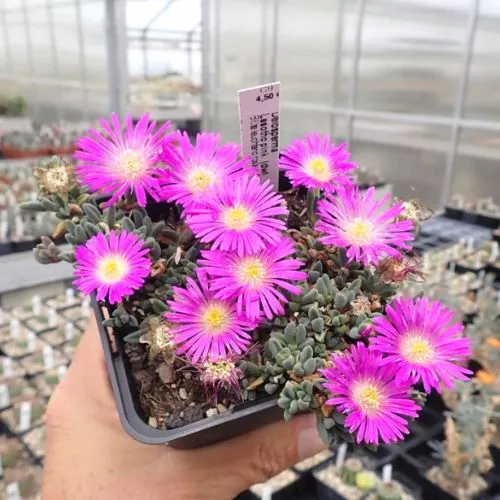
It thrives best in full sun and prefers well draining soil. Furthermore, it is drought tolerant and can go for longer periods without water. Overwatering, on the other hand, can cause root rot and an early end of life.
Euphorbia Milii Pink
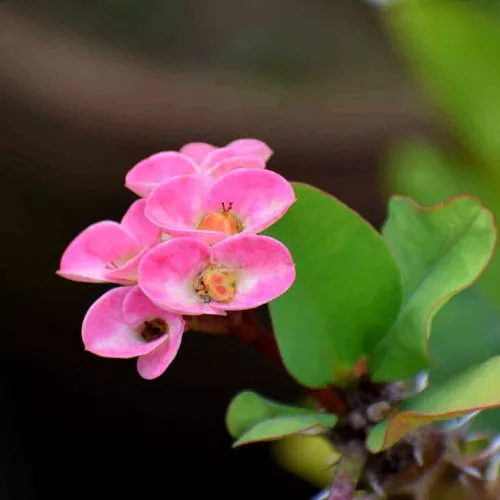
The Delosperma (a.k.a wheels of wonder, hot pink wonder) is a beautiful, showy, evergreen succulent native to South Africa. This beautiful, early summer to fall blooming plant produces quite sizable, bright pink flowers with yellow centers.
They almost resemble the common daisy. These plants can grow up to 4-6 inches (10-15 cm) in height and spread to around 18-24 inches (45-60 cm). The Delosperma is a great beginner plant with its ease of growth and low maintenance.
It thrives best in full sun and prefers well draining soil. Furthermore, it is drought tolerant and can go for longer periods without water. Overwatering, on the other hand, can cause root rot and an early end of life.
Crassula (Morgan’s Beauty)
Crassula Morgan’s Beauty (a.k.a Morgan’s Pink) Is a compact, evergreen succulent native to Southern Africa.
This mesmerizingly pudgy house plant produces its sweetly scented, dark pink flowers from winter to spring.
The Crassula has been documented as having grown up to around 4 inches (10 cm) in height and the same in the overall spread. The Crassula is another plant that beginners may enjoy.
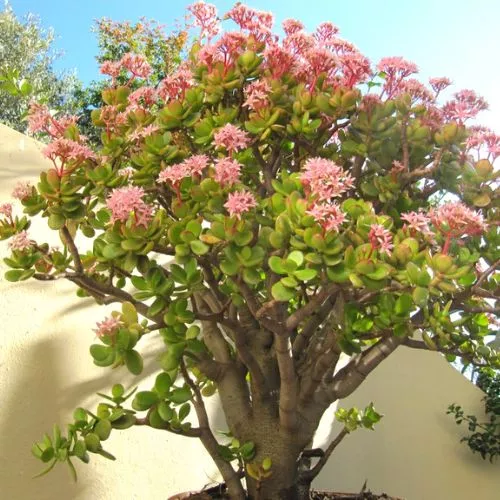
It requires slightly more water than most succulents and can be offset with well draining soil to keep the moisture content down away from the roots. These plants love full sun earlier in the day and semi shade later. Their drought tolerant nature makes them a good choice outdoors and as houseplants.
Rock Purslane
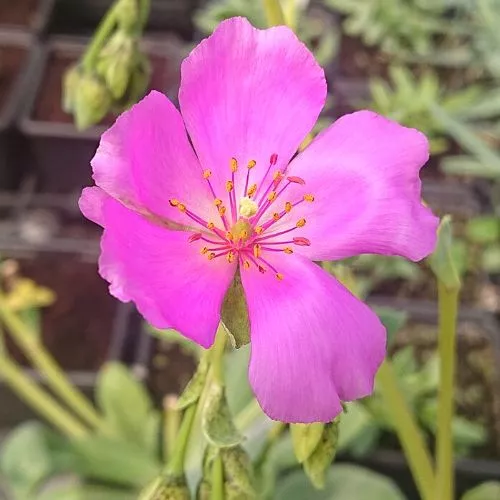
Rock Purslane (a.k.a. Cistanthe Grandiflora or Calandrinia spectabilis) is a petite and tender perennial native to Chile.
This wonderful plant produces charming cup shaped fuschia flowers all year round.
The Rock Purslane has some pretty impressive growth dimensions for its petite nature. It can max at 12 inches (30.5 cm) tall and easily spread to around 2-3 ft (60-90 cm).
This beautiful species of succulent thrives best in a partly sunny location earlier in the day and with some well deserved respite in the afternoon. They need well draining soil, like most succulents, to help keep the roots from rotting. The Rock Purslane is also drought and heat tolerant.
Epiphyllum Pink
Epiphyllum Pink (a.k.a orchid cacti) is a showy, evergreen cactus native to Central America.
The pink orchid cactus has been a household favorite for as long as gardens have been showrooms.
This night-blooming, hanging plant produces beautiful, electric pink flowers, often a sight to behold.
These electric pink cacti can reach heights of 10 ft (3 m) by 3 ft (1 m) across at full maturity.
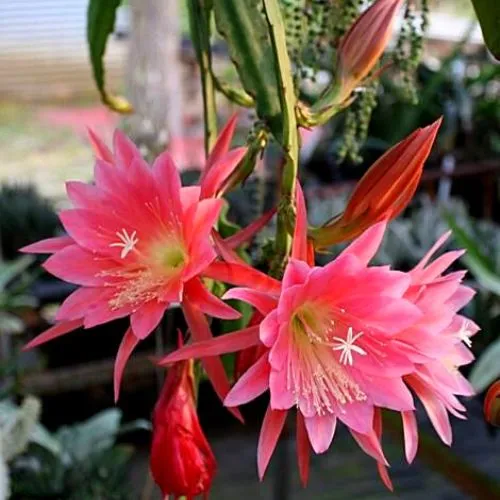
Like most orchids, the Epiphyllum loves the sun but will need some kind of shade in the hottest parts of the year to protect it from scorching. This pink beauty loves good watering. But it’s important to ensure that the soil is draining to prevent any root issues from arising due to overwatering.
Kalanchoe Fedtschenkoi
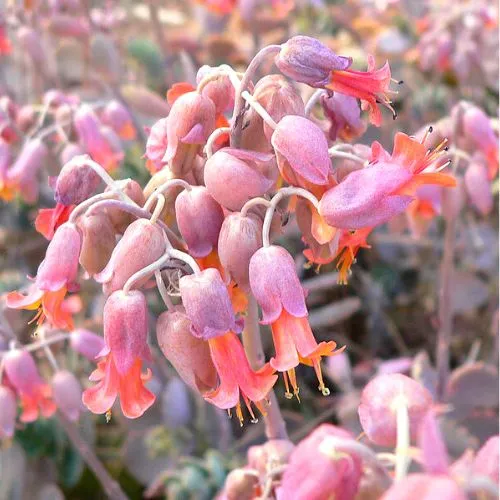
Kalanchoe Fedtschenkoi (a.k.a Bryophyllum Fedtschenkoi) is a low-growing perennial succulent native to Madagascar.
The Kalanchoe is more of your traditional looking succulent with pink edged, fleshy leaves and tubular shaped flowers, which come to life late in the spring to early in the summer.
This compact succulent doesn’t offer much in the way of height and spread. It generally stops growing at around 1-2 ft (30-60 cm) tall.
Its spread is almost non-existent due to its subtle stems and leaves. The Kalanchoe is a partial sun, partial shade variety. They don’t like extreme colds but surprisingly go dormant in the summer.
Their water frequency should be smaller amounts more often. Like almost all succulents, adequate drainage is essential.
Aptenia Cordifolia Variegata
Aptenia Cordifolia Variegata (a.k.a Variegated Baby Sun Rose, Variegated Dew Plant, Variegated Rock Rose) is a trailing succulent perennial native to South Africa.
This hardy traditional succulent produces bright pink to purple, smaller, daisy shaped flowers during the spring and summer.
The Aptenia grows more outwards than upwards. It is 6 inches (15 cm) high and 1-2 ft (30-60 cm) wide. This wonderful little pocket rocket is easy to grow and thrives best in full sun.
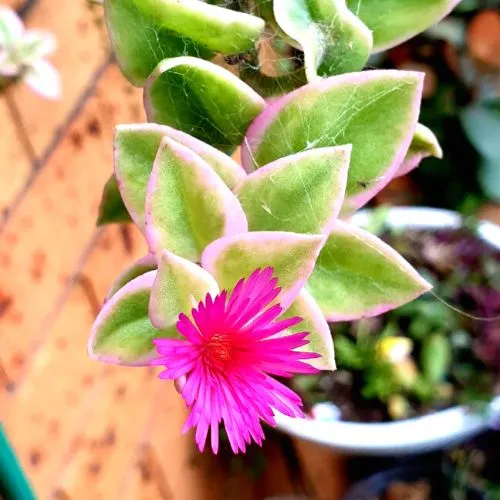
It likes to be watered regularly but needs well draining soil, such as loamy sand, to ensure the water doesn’t pool around the roots. It should be kept dry during the colder winter periods and fertilized in the spring.
Echeveria Peacockii
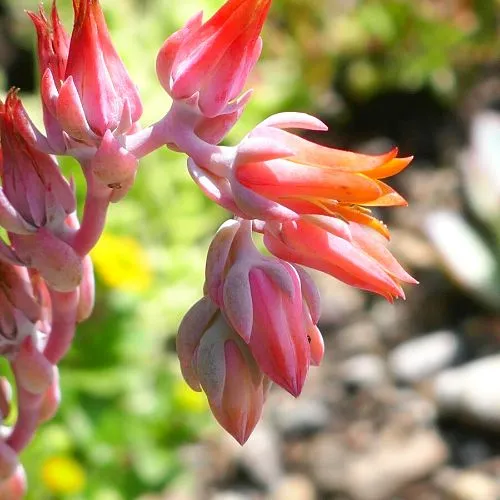
Echeveria Peacockii (a.k.a. Peacock Echeveria, Echeveria Desmetiana) is an attractive, fast-growing evergreen succulent native to Mexico.
The ‘Peacock plant’ is another one of the traditional types of succulents.
It produces intriguing, curled, hook shaped stems with smaller spikes containing bright orange to red and pink flowers. This compact succulent barely grows from 3 inches to 1 ft (7-30cm) tall and spreads 4-6 inches (10-15cm) outwards.
The Echeveria Peacockii prefers full to partial sun and are quite drought tolerant. Overwatering can become an issue, but ensuring good quality, well draining soil can help alleviate any excess moisture overload. No fertilizer is required for this plant; applying any can be detrimental in causing burning.
How often do you water a succulent/cactus flower?
Many variables can contribute to the amount of water that succulents, cacti, and their soil, can absorb. Furthermore, absorbing and needing are two different concepts. The excess water can be fatal for the plant if a plant is grown using a soil type that doesn’t offer adequate drainage.
The moisture can be soaked in by the soil and held to the root system, causing a pooling effect. When the roots sit in the stagnant, pooled water for too long, the roots can rot and kill the plant.
In contrast, a plant that has well draining soil to grow in will use only what it needs and have the ability to grow faster. Additionally, the soil will help with aeration and nutrient delivery.
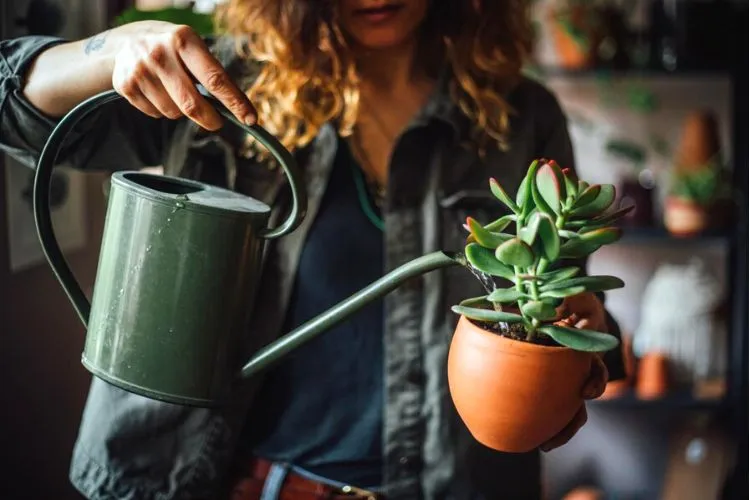
So, the amount of water a succulent or cactus requires should generally be applied case by case. You should always check the moisture content before watering to ensure that the soil is completely dry.
This can be done by simply striking your finger or even a pencil/chopstick down the side of the stem into the soil. If the probe comes up dry, then it’s safe to apply some water.
Regarding frequency, it’s best to check the moisture content 2-3 times per week and water accordingly. Little to no water will be required during the colder months as most succulent and/or cacti species can use their stores to help them through that period.
Lastly, many factors, such as light conditions, climate, humidity, soil characteristics, etc., can also affect the amount and consequential frequency a plant may need.
What to do with succulents after flowering?
Many succulent species can produce some pretty amazing blooms. Once they’re done, though, it’s always hard to know how to deal with post flowering plants such as these. We recommend cutting the bloomed stem as low as you can down at the base.
Be careful not to prune away any leaves that may be in the way. Always use a clean, sterilized pair of sharp gardening scissors or pruning shears.
You may need to use one hand to pull away any high growing foliage to maneuver the pruning tool into place.
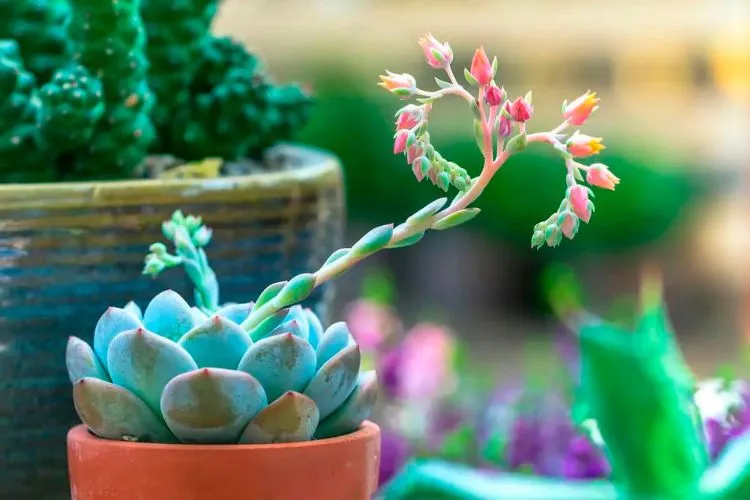
Going through this process after each bloom will assist the plant with regeneration. Remember, a plant has a limited supply of energy.
When it uses this energy to try to keep dying flowers alive, it can’t focus much, if any, of its remaining energy on the rest of the plant. Therefore, it’s much more beneficial to remove the dead flowers asap.
Some growers clip them as they’re growing for the first season to allow the succulent to concentrate all of its energy on producing a strong, healthy base.
Then the next season, they will produce even better blooms. Their type defines the number of seasons. Also, they can be annuals, biennials, perennials, etc.
Frequently Asked Questions (FAQs)
How long does a succulent flower last?
Depending on the species, light availability, climate, etc., succulent blooms can last anywhere from a day to weeks and sometimes 1-2 months.
How often do succulent plants flower?
Succulents generally flower once per growing season or cycle. However, this all depends on what type of succulent they are. Annuals flower once per year, then die. Biennials flower once per year for 2 years, then die. Perennials can live many years but may take a few seasons to flower.
Is it rare for succulents to grow flowers?
Most succulents can flower, but their growing conditions will ultimately decide whether they do so. For example, colder temperatures, inadequate light, old age/immaturity, etc., may not allow flower growth. Whereas growing a succulent with optimal conditions will flower exactly as it should according to its type.
Should I cut off Echeveria flowers?
This is a bit of a 50/50 question. On the one hand, you want the plant to focus its energy on growing the plant itself, although its blooms are amazing. On the other hand, allowing the stems and blooms to grow will help the plant obtain more exposure to sunlight. It’s always ideal for cutting off diseased, dead, or broken stems, flower stalks, and leaves to ensure regeneration. The answer to this is more of a personal preference.
Conclusion:
When it comes to succulents, highlighted colors aren’t the first thought on anyone’s mind. We usually think about small cacti and straight up green, ornamental desk dwellers.
Surprisingly, these dazzling succulent with pink flowers variants are an amazing addition to any growing space. We hope that this article has been informative as well as helped you decide which one of these unique species can suit your garden.
We look forward to seeing you at the next one. As always, happy growing!


